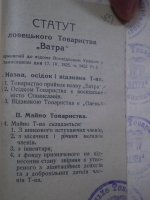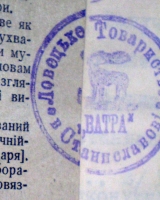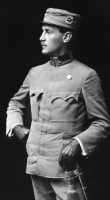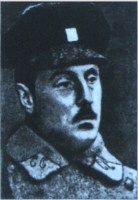Kost (Kostiantyn) Voyevidka

Kost Voyevidka was born in the family of Lev Voyevidka in Prague on July 5, 1891. He obtained a medical education and Doctor of Medicine.
Kost Voyevidka was not only a brave warrior of the Kish of the Legion of Ukrainian Sich Riflemen (Ukrainski sichovi striltsi [USS]), but also a savior. There was a division affiliated to the Kish for taking care of sick people. The doctors of the Kish were Dr. Ivan Rykhlo, Dr. Kost Voyevidka in 1914, Dr. Volodymyr Bilozor in 1915 and 1917, and Dr. Volodymyr Shchurovskyi in 1916. Some time later Dr. Voyevidka organized a hospital and taught medical and nursing personnel for the Ukrainian Insurgent Army.
He was a chief physician of the Kish of the Legion of USS in February 1915. After the reorganization of the Legion into the regiment in 1916, Dr. Beliai organized the service of the kurin doctors of the regimental sanitary chief. He was replaced by Dr. Kost Voyevidka.
Since 1919 Dr. K. Voyevidka has become the Chairman of the Ukrainian Red Cross Mission in Berlin with the assistant – sotnyk Luhovenko. The objective of the Mission was primarily the purchase of medical equipment, medical supplies, clothing, linens, and beddings for the Ukrainian military forces. The medicine was bought directly at pharmaceutical factories in Germany and Switzerland. An important task of the Ukrainian Red Cross was also to set up international cooperation and protect potential refugees and prisoners. That’s why after the death of A. Vyazlov in November 1919 A. Okonenko was appointed again as the head of the Ukrainian Red Cross (URC). However, for the purpose of communication with all offices of URC in the European countries (Berlin, Geneva, Prague, Rome, Belgrade, Bucharest, Warsaw) and prisoner camps of migrants from Ukraine to Western European countries, the leadership of Dr. Okonenko was mostly outside Ukraine in Vienna, where the head office of the Red Cross was located.
Dr. Okonenko made some appointments for the foreign communication: Dr. Borys Matiashenko was the member of the Peace Delegation of the UPR in Paris (for negotiating with Antanta powers regarding aid to Ukraine); Dr. P.Kholodnyi and Dr. K. Voyevidka were appointed to Berlin, Dr. Verbynets - to Belgrade, Dr. Ie. Lukasiewicz – to Warsaw; D. Doroshenko was appointed as the Head of the Health Care unit in the Balkan states, then in Bucharest, and in January 1921 he moved to Vienna. The Government of the UPR made O. Sevriuk responsible in Italy for repatriation of 100 thousand Ukrainian prisoners from there.
On January 20, 1918 the Combat Board of the Ukrainian Sich Riflemen decided to reorganize the Galicia-Bukovyna Kurin of the Sich Riflemen into the I Kurin of the Sich Riflemen, because the Kurin became a military unit of the whole Ukraine, not only of Galicia and Bukovyna. The Riflemen Council was attached to the Kurin. It was a deliberative body under the Kurin`s commander. All the foremen of the USS: Eugene Konovalets, Fed Chernyk, Andriy Melnyk, Roman Sushko, dr. Kost Voyevidka, Ivan Chmola and Vasyl Kuchabskyi were the members of the Riflemen Council.
Kost Voyevidka was also an active public man. In the 1920s, due to the escalation of the national problem in Poland, which included the occupied western lands at that time, there were organized hunting societies. The dominant factor of their formation was the belonging of members to a certain ethnic group. The first hunting society was “Tur”, Dr. Kost Voyevidka became its member soon. The Ukrainian Hunting Society “Tur” was founded and located in Lviv, 11 Dominican st. Since 1937 the Society organized together with the journal “New Era” a self-publishing application “Lovetstvo.” The first journal was issued on March 27, 1937. It was the beginning of the hunting periodicals publishing in Ukraine. Before the foundation of the hunting society “Vatra” (the Fire) Ukrainian hunters in Stanislav belonged to the Polish society “Hubert”, chaired by the senior treasury advisor Juliusz Salvah. Majority of the “Hubert” members were the Poles, that was why the Society was of a pro-polish orientation. Because of that Kost Voyevidka founded the hunting society “Vatra” in Stanislaviv in 1925. According to information, presented in the anthology of Stanislav in 1975, the Ukrainian Hunting Society “Vatra” appeared in Stanislaviv in 1932, although the data from Ivano-Frankivsk State Archive did not confirm this date. There is a document stating that the statute of “Vatra” was considered by the Stanislaviv government on April 17, 1925. It was mentioned that the location of the Society was Stanislaviv and the emblem - a deer.
After the war he lived in Stanislav, where he worked as the head of the district hospital (at that time it was called a general hospital), which was built in 1834 and opened in 1842.
Kost Voyevidka led his medical practice and headed the district Centre “Ridna shkola” (the Native School). “Ridna shkola” is a public society that dates from 1881, when the Rus Teacher Association was founded in Lviv (in 1912 it changed its name to Ukrainian Pedagogical Society (UPS), and in 1926 to the Ukrainian Pedagogical Society – the Society “Ridna shkola”). The founders of the Society were the Ukrainian teachers Anatole Vakhnianyn, Omelian Oronovskyi, Omelian Partytskyi, Omelian Sawyckyi, Roman Zaklynskyi and other Ukrainian statesmen. The mission of the Society was to preserve the Ukrainian school under the rule of foreign countries, to educate the young generation in love to Ukraine and to provide students with high-level knowledge. The Society together with “Prosvita” and other public organizations turned to the national and spiritual liberation of Ukrainians in Galicia.
Kost Voyevidka was a good friend, a companiable and brave man. He was a good friend of Osyp Sorokhtey. He was friends with his military comrades and colleagues. “We were sent to the trenches near the Kuropatnyky village. We were on the edge of the forest, and our Priest [Julian Fatsiyevych] frequently visited us. He sometimes walked in the trenches, talked with the guys, and on Sundays said the Mass and confessed in the forest. We all loved him for his kindness and cheerful disposition. Sometimes in the evenings he came to our dugouts: we were chatting a lot, playing whist and drinking wine. I remember that once the Priest, Dr. Kost Voyevidka, Osyp Bukshovanyi and I (i.e. Roman Kupchynskyi) got together in the dugout of Vasyl Didushka and played whist.
Suddenly a grenade hit our dugout. The beams cracked, but didn’t break, only some ground poured on us. We all kept silent and listened to the cannonade that moved right to the Magyars. After a long silence, the Priest said, “It is very good that wine glasses are empty, in other case the wine would litter,” recalls Kupchynskyi.
In March 1944 Kost Voyevidka with his wife and son were shot in Stanislav by Gestapo men.
References
1. The Scientific Herald of the National Forestry Engineering University of Ukraine, no. 19.13, 2009, pp.25-30.
2. Mykola Lazarovych, The Legion of Ukrainski sichovi striltsi: their forming, idea and fight,Ternopil, Dzhura, 2005, p.592.
3. Svyatoslav Lypoveckyi, The Visage of Victory (the photos of sichovi striltsi), Lviv, the Publishing House “ARS”, 2012, p.96.
4. Ivan Homa, Sichovi Striltsi. Their forming,political and military activities, and the armed fight of Sichovi Striltsi in 1917-1919,Kyiv, the Publishing House “Nash Chas”, 2011, p.104
5. Dr. V.Trembickyi, Ukrainian Society of the Red Cross 1918-1923. Available from: http://komb-a-ingwar.blogspot.com







